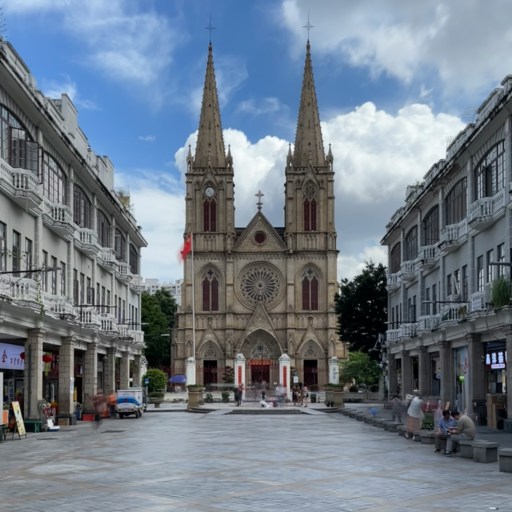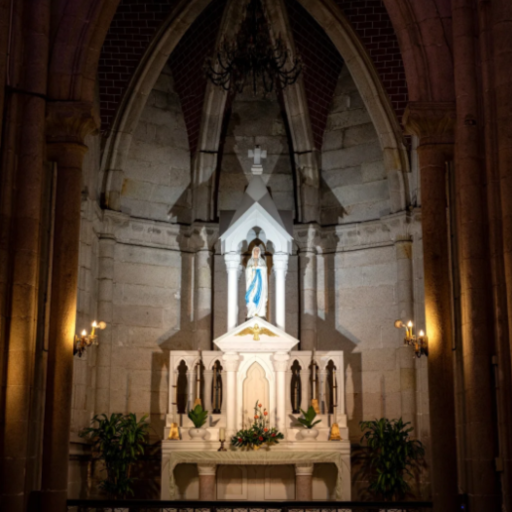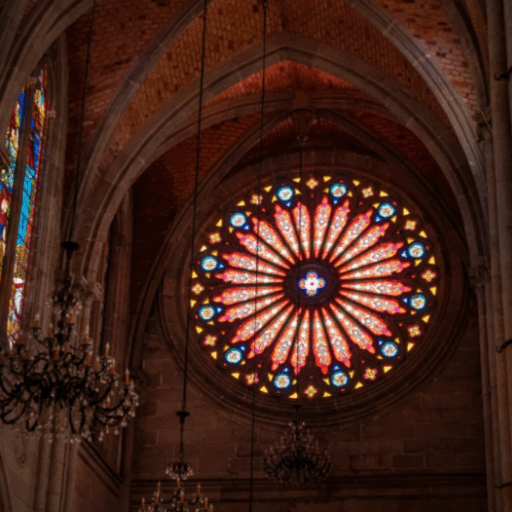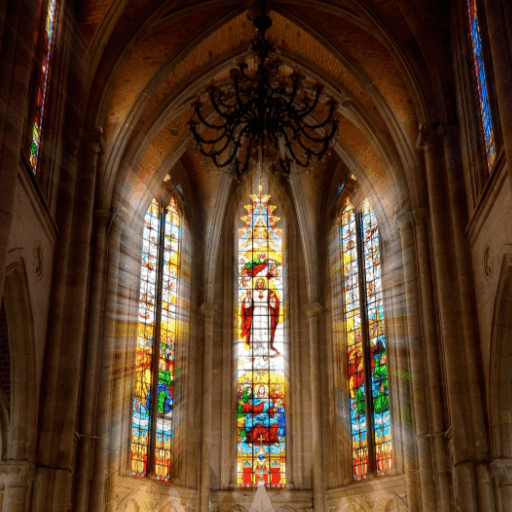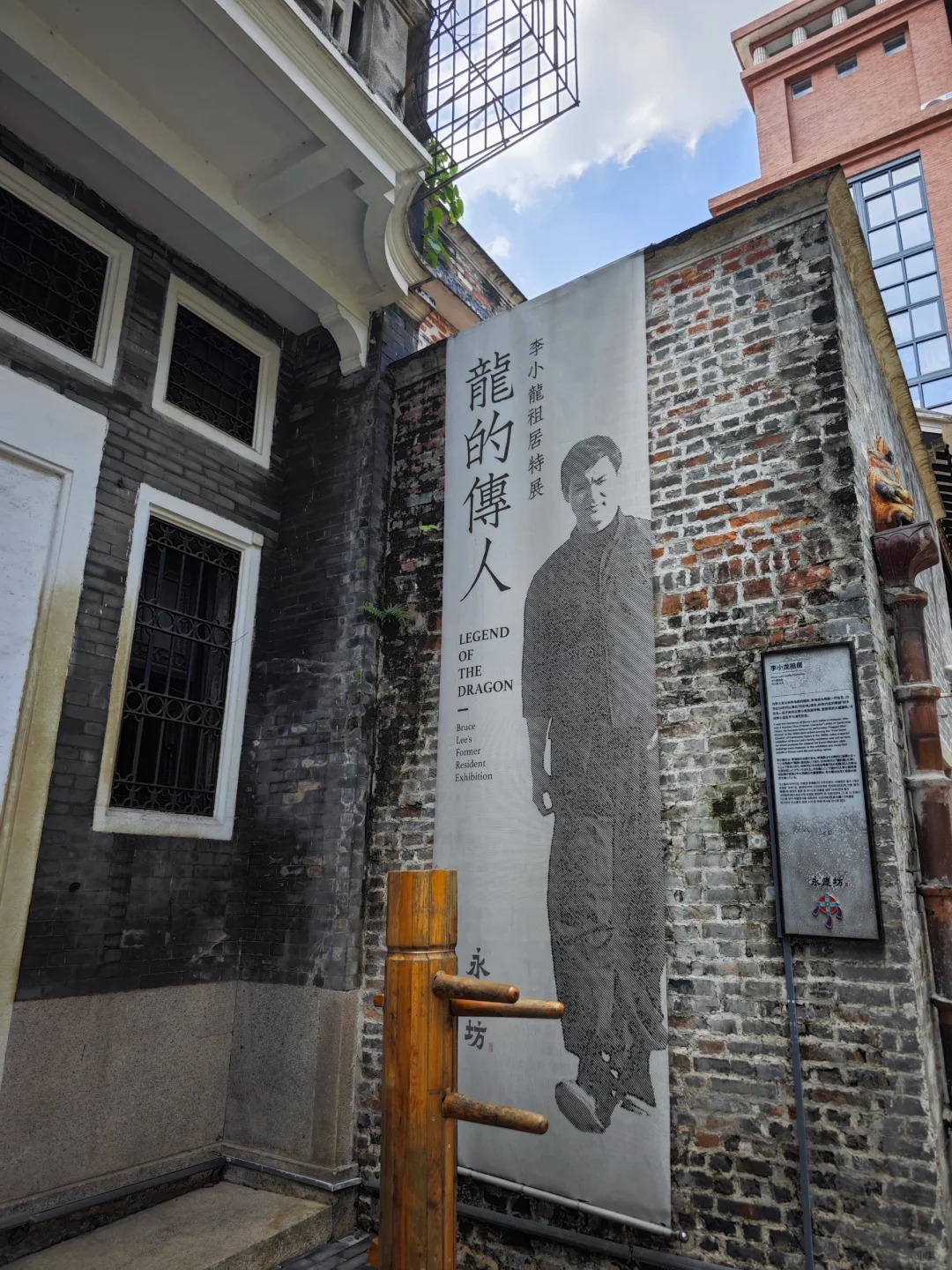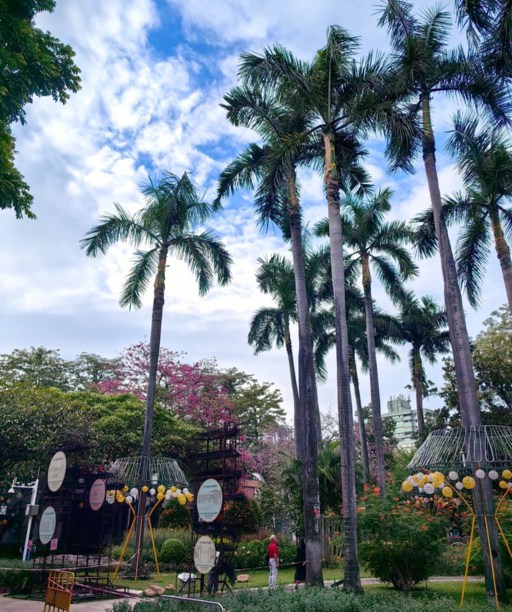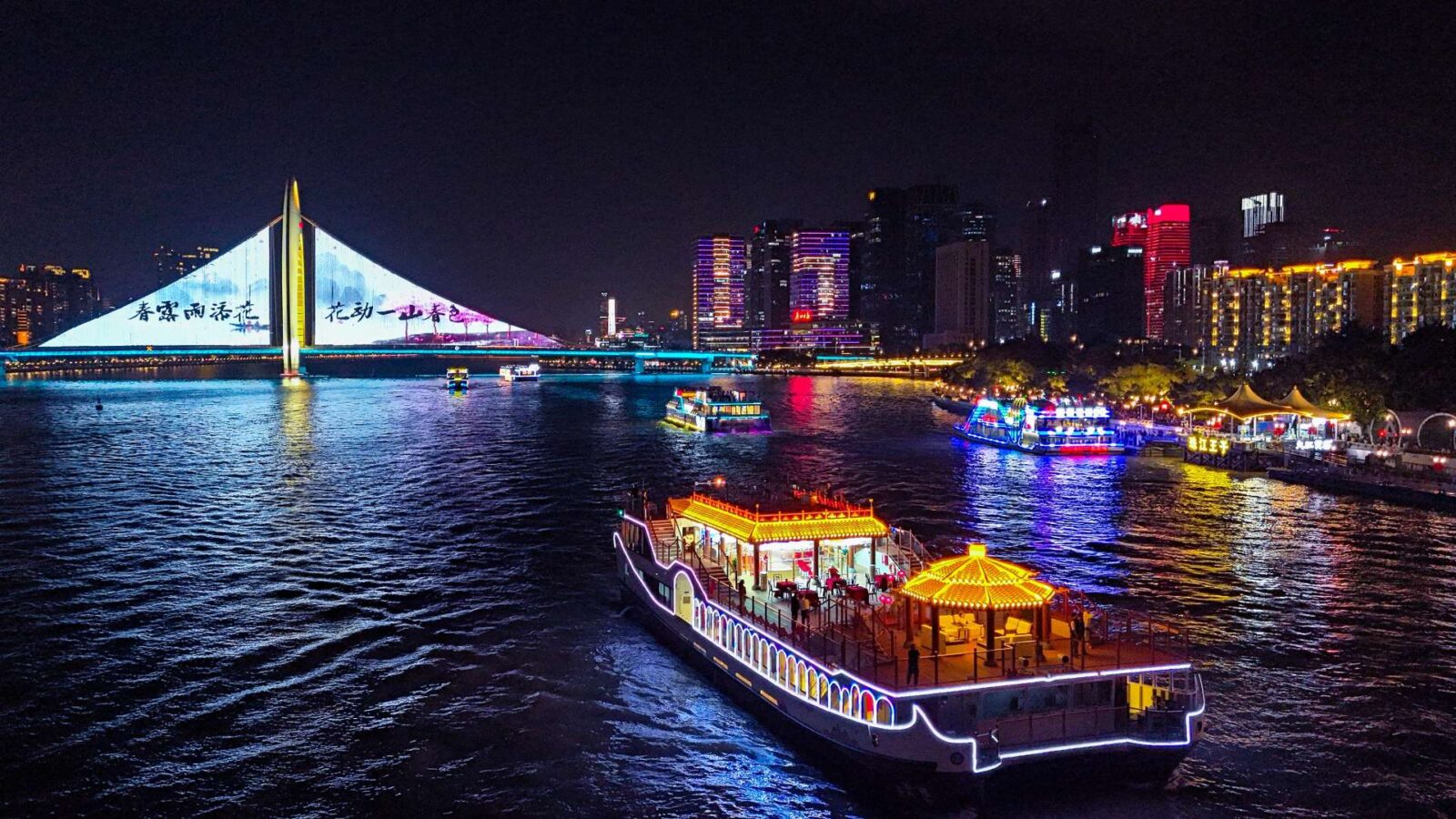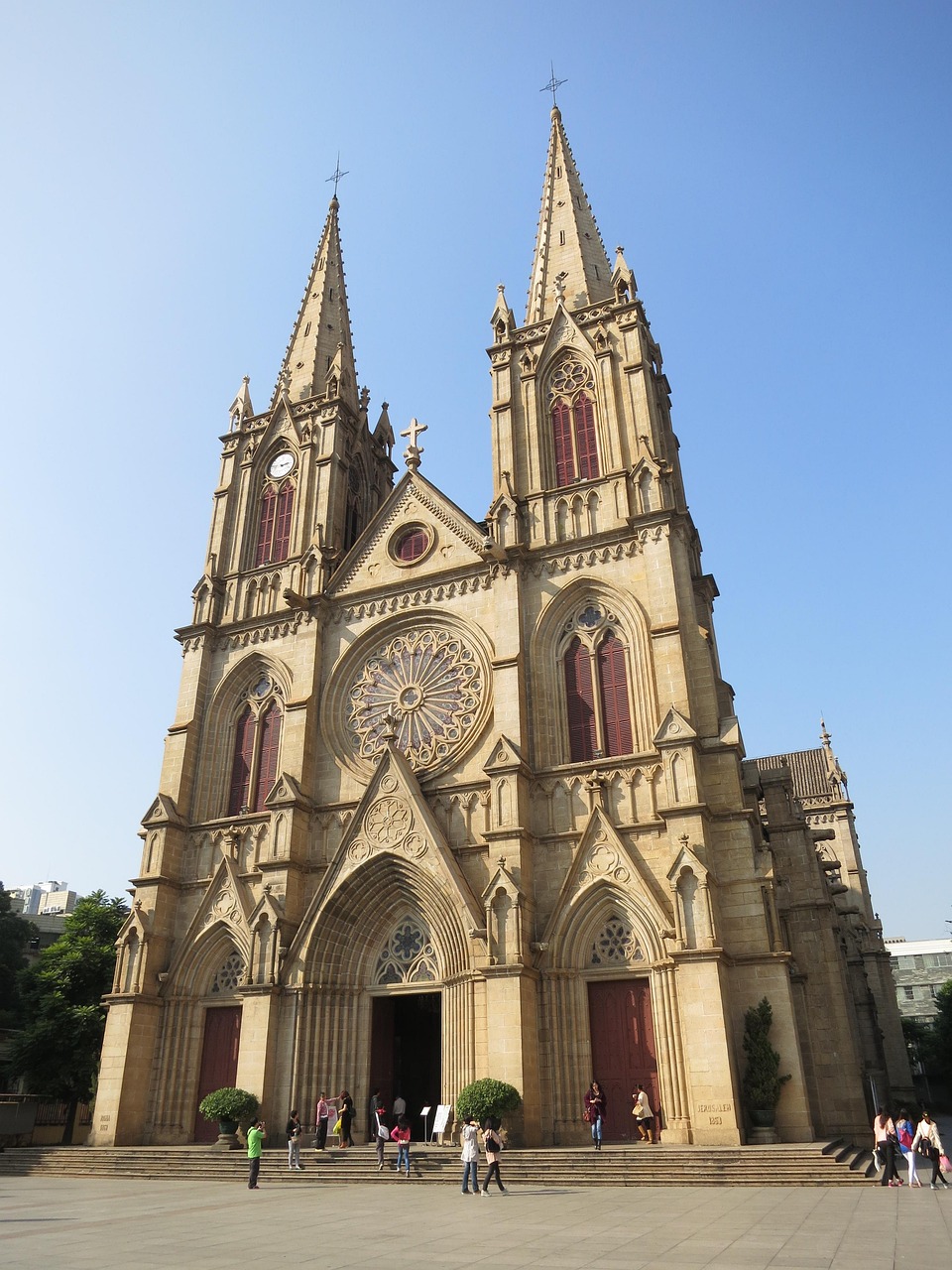
Sacred Heart Cathedral
The Sacred Heart Cathedral is one of the few places in Guangzhou that a first-time visitor is likely to be amazed by. Lying buried in the middle of wholesale markets and cross lanes, the granite church seems to emerge out of thin air with two Gothic spires which pierce the sky. Its massive size is surprising in a city that is more reputed to have dim sum teahouses and skyscrapers. If you enjoy discovering historic religious sites tucked inside bustling city streets, you might also like reading about the City God Temple of Shanghai.
Visitors refer to it as the Stone House, which is the appropriate name to give it after one enters. Light scatters from the stained glass onto the wooden pews, while the bells’ sound floats across the Pearl River. Tourists usually make quick stops to take photos, yet most spend more time appreciating the cathedral’s tranquility compared to the world outside. Sacred Heart Cathedral Guangzhou is not an ordinary tourist site; it stands as a historic place where past, religion, and daily life still converge.
A Brief History of the Sacred Heart Cathedral Guangzhou
- Outside of Sacred Heart Cathedral
- Granite Church
Origins and French Influence (1861–1888)
The history of the Sacred Heart of Jesus Cathedral began in 1861 when French missionaries arrived in Guangzhou. They dreamed of establishing a permanent religious hub to serve the growing Catholic population. Napoleon III and the French Catholic Church contributed funds, enabling them to select an unusual but symbolic site: the remains of the former Governor Palace of Guangdong, destroyed in previous wars. The construction of a sacred heart catholic church on this land was a symbol of faith and political goodwill.
The building took place during a period of almost twenty years before it was finally completed in 1888. Carmen sculptors took granite out of the local quarries and French designers fused local technology with Gothic design. The work was a challenge--materials were to be delivered by the Pearly River and they were all but to be done by hand. However, the outcome was a success: an airy church fused European visions and South China stable spirit.
Surviving Wars and Cultural Upheavals
The cathedral faced turmoil within Guangzhou’s Catholic community throughout the 20th century. During the Second Sino-Japanese War, attackers broke windows and ransacked the interior. Later, during the Cultural Revolution, officials cut off the bells, leaving the cathedral without worship and forcing it into suspension. Residents still recall how the building stood unoccupied, its towers worn but unshattered, silently witnessing the city’s upheaval.
Restoration began only in the 1980s as China gradually reopened. Workers repaired the stained glass, restored Mass services, and revived the cathedral as Guangzhou’s Catholic center. Worshippers and visitors still marvel that despite decades of turbulence, the church survived intact, never losing its enduring spirit.
Architecture and Symbolism
A conspicuous aspect of the Sacred Heart Cathedral Guangzhou history is that it was constructed with all granites which is not common even in Europe. The building is made of stone; every wall, column, arch is hewn out, making it so much the better known by the local name, which is, Stone House. The Gothic style is instantly familiar: pointed arches, ribbed vaults, twin spires that are almost 60 meters high.
But it is not a duplicate of the cathedrals at Paris. Although it takes the shape of Notre-Dame, its materials and the surroundings bring it back to South China. The huge granite blocks are signs of permanence and the stained glass narrates about endurance. To the locals, the cathedral is not only architecture; it is the reminder of the way in which the world faith traditions may find their home at the Pearl River.
Opening Hours, Location, and How to Get to Sacred Heart Cathedral Guangzhou
Quick Facts : the Sacred Heart Cathedral Guangzhou at a Glance
| Information | Details |
| Official Name | Sacred Heart Cathedral of Guangzhou / Cathedral of the Sacred Heart of Jesus |
| Chinese Name | 广州石室耶稣圣心主教座堂 |
| Address | No. 56 Yide Road, Yuexiu District, Guangzhou |
| Opening Hours | 08:00 – 17:30 daily (may vary during Mass or religious holidays) |
| Entrance Fee | Free |
| Reservations Required | No, except for group visits or guided tours |
| Recommended Visit Duration | 1–2 hours |
| Nearby Metro Stations | Yide Lu Station (Line 6, Exit A), Haizhu Square Station (Line 2/6, Exit B2) |
| Nearby Attractions | Pearl River, Shamian Island, Beijing Road |
Exact Address and Surroundings
The official Sacred Heart Cathedral, Guangzhou address is No. 56 Yide Road, Yuexiu District. Unlike most churches in quiet squares, this cathedral stands in the middle of the old commercial quarter. The neighborhood hosts wholesale markets selling plastic toys, wedding decorations, and dried seafood in bulk, all packed into narrow streets crowded with vendors and scooters. Walking through here can feel chaotic, which makes the cathedral’s Gothic towers appear even more impressive when they suddenly emerge.
If you are planning a visit, there’s also much to see in the area before or after entering the church. If you want to explore more of Guangzhou’s highlights along with the cathedral, check out Guangzhou City Tour. There are old-fashioned snack shops along the lanes that sell roasted chestnuts, herbal teas and rice cakes. The Pearl River is just a short walk away and provides a quieter setting if you feel the need to escape from the bustling market environment. For photographers, this contrast of somber stone walls against the bustle of Guangzhou street scenes is part of the appeal of the cathedral.
Metro and Public Transport Tips
The easiest way to get the cathedral is by metro. Take Line 6 to Yide Lu Station, exit A, and it’s less than a five-minute walk from there. I guess this is the most straightforward for those who are looking “sacred heart cathedral – guangzhou metro”. The walk, too, is straightforward: emerge from the station and walk west on Yide Road; the spires will appear soon enough.
Or you can alight at Haizhu Square Station(Line 2 or Line 6). From Exit B2, you’re about 10 minutes away by foot through the wholesale markets. This route shows the local neighborhood better, but streets get crowded during peak shopping hours. City buses run along Yide Road, yet traffic delays make the metro usually faster for travelers asking how to get to Sacred Heart Cathedral Guangzhou by bus. Taxis and ride-sharing like Didi are common, but drivers may drop passengers a block away because one-way streets are narrow. Carrying bags can be tiring, so plan your route near metro stations to avoid hauling suitcases through busy markets.
Visiting Sacred Heart Cathedral Guangzhou — What to Expect
- Sacred Heart Cathedral Guangzhou Inside
- Stained Glass Church Interior
Mass Times and Religious Services
Before attending service, always check Sacred Heart Cathedral Guangzhou mass times in advance. Sundays usually feature Mandarin and Cantonese Masses in the morning, while English and Korean services take place later in the day. Weekday services run shorter, less dramatic, and mainly attract local parishioners instead of visitors.
During major church holidays, the schedule may change, so it is better to confirm on site or follow parish announcements. Recent TripAdvisor reviews noted that mass times sometimes shift without notice, particularly around Easter and Christmas seasons.
Dress Code and Visitor Etiquette
Lots of tourists question: what should one wear in the Sacred Heart Cathedral Guangzhou? Although there is no fixed dress code like in certain European cathedrals, modest dress is expected-covered shoulders and knees are welcome particularly when you intend to attend Mass and photography is welcome but should be done in a subtle way, you should not use flash when taking pictures in the church.
One of the travelers once said that he was tenderly reminded by one of the volunteers to take off his hat before entering, a minor point, but something that demonstrated that the space is treated with respect. Silently praying and not venturing into the restricted zones will facilitate the visit.
Interior Highlights
It is the interior where the cathedral becomes the bright spot. Sunlight penetrates the stained-glass windows, casting red, blue, and gold patterns onto the stone floor, attracting visitors photographing the Guangzhou Sacred Heart Cathedral. The side chapels remain quiet, featuring small altars and votive candles, which enhance the cathedral’s calm and tranquil atmosphere. The Gothic, ribbed vaulted ceiling draws eyes upward, creating a similar effect to Paris or Milan cathedrals, yet it is fully built from Chinese granite. Visitors should not overlook the bell towers, where the bells’ sounds carry across the Pearl River, offering one of the cathedral’s most distinctive experiences.
New Organ and Music Tradition
The cathedral has recently added a new pipe organ, a rare feature in churches of southern China. You may wonder about this organ in the Cathedral of the Sacred Heart. It is a modern instrument, designed to match Gothic acoustics, blending ancient art with advanced technology. The cathedral also hosts periodic concerts, and even during rehearsals, the music echoing through the granite nave remains unforgettable.
Services are usually accompanied by local choirs and this brings some kind of a cultural resonance which unites the Catholic and the whole world. To the music enthusiasts, listening to the organ concert can be as good as visiting the stained glass.
Travel Tips and Photography Insights
Best Time of Day to Visit
If you want to capture memorable pictures of the Guangzhou Sacred Heart Cathedral, use your camera before time slips away. Mornings, around 8–9 a.m., offer the most pleasant light as sunlight streams through the stained-glass windows, and the square outside stays empty. Sunset also works well, especially when the twin towers glow against a sinking orange sky. By midday, tour groups fill the courtyard, and the sun becomes too harsh for photos. On weekdays before noon, you can enjoy an unobstructed view of the facade without crowds.
Pitfalls to Avoid
Expect misfortune if you arrive on Monday, since the cathedral closes for routine maintenance, which surprises many first-time visitors. On Catholic feast days like Easter, long lines form both to enter and to find seats inside. Travelers also report nearby vendors selling overpriced souvenirs; it’s not a scam, yet the same postcards often cost half at Beijing Road stalls. In my experience, security checks at the gate take longer than expected, especially on weekends, so avoid tight schedules. TripAdvisor reviews support this: people usually enjoy the cathedral, yet some regret not checking opening hours in advance.
Suggested Half-Day Itinerary
Go here in combination with nearby cultural stops. Start your morning at the cathedral, then walk or take a short ride to Shamian Island, with colonial-era buildings and tree-shaded streets offering a slower contrast to the cathedral’s grandeur. Stop for lunch at a riverside café, then head toward Beijing Road, a pedestrian street mixing Macau’s historic ruins under glass panels with modern shops. Keep coins or small notes ready, as some snack stalls still accept cash only. This route balances history, architecture, and street life, perfect for travelers spending just a few hours in central Guangzhou.
Cultural Significance of the Sacred Heart Cathedral Guangzhou
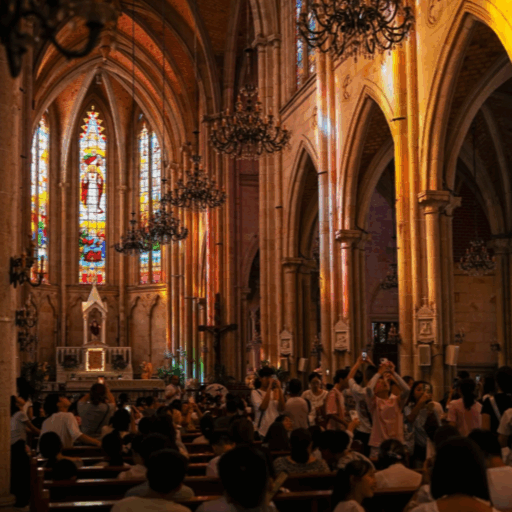
People in Cathedral
A Meeting Point of East and West
But the Sacred Heart Catholic Church is more than just a religious structure; it’s also a cultural conduit. Its French Gothic architecture rises above Guangzhou’s old trading quarter, while incense from nearby Chinese temples scents the air. On Sundays, worshippers leave Mass as curious travelers enter, exploring granite walls and stained glass windows. This mingling of worship and observation gives the cathedral life — East meets West not only through architecture but also through human interaction.
Local Community and Catholic Life
It is the most significant Guangzhou Catholic church for local congregants. It welcomes baptisms, weddings and packed Christmas Eve services that flow into the square. At Easter, volunteers fill the altar with lilies, and hymns in Cantonese and Mandarin reverberate through the nave. In Guangzhou, even non-Catholics turn out during these festivals, regarding the cathedrals that serve them also as communal cultural sites. It ensures Catholic life remains on display in a city more associated with commerce than cathedrals, rooting a small but stubborn community amid the hustle of modern Guangzhou.
FAQ about Sacred Heart Cathedral Guangzhou
Q: What is the dress code for the Sacred Heart Cathedral Guangzhou?
When they visit the cathedral, it is recommended that visitors wear modest clothes. Visitors should cover shoulders and knees, especially during Mass, and remove hats, avoiding casual shorts or sleeveless tops. TripAdvisor reviews note volunteers politely remind tourists about these rules without forceful enforcement. Dressing respectfully also benefits visitors, preventing any unpleasant attention while experiencing this historic religious area.
Q: Can you go inside Sacred Heart Cathedral?
Admittedly, visitors are allowed to enter the majority of the cathedral, such as in the main nave, side chapels and the courtyard. Mass (or special ceremony) may involve some closed areas. The interior is beautiful with experiences of the stained glass, Gothic arches, and the bell towers. They are advised to go when there are no crowds as it is the best way to experience everything that it has to offer without being crowded and also to see how people behave when they are worshiping.
Q: What is the history of the Guangzhou cathedral?
The cathedral, officially called the Sacred Heart of Jesus Cathedral, was built between 1861 and 1888 under French missionaries’ direction, aided by Napoleon III. It sits on the former Guangdong Governor Palace site, and the entire structure uses granite. The cathedral survived wars and political upheavals, including the Cultural Revolution, underwent several restorations, and continues forming the core of Guangzhou’s Catholic community.
Q: What is the new organ in the cathedral of the Sacred Heart?
A modern pipe organ was newly erected in the last few years to suit the Gothic acoustics of the cathedral. It works for both Masses and the occasional concert, mixing old-school craftsmanship with modern digital controls. Visitors say this hunk of granite even sounds impressive, with rehearsals echoing throughout the nave. This new organ not only consolidates the tradition based on which the plethora of music at the cathedral has been founded, but also breathes fresh, modern life into a building over 1000 years old.
Q: Sacred Heart Cathedral Guangzhou mass times — when are services held?
The cathedral holds Masses nearly every day. On Sundays, morning services are in Mandarin and Cantonese, afternoons in English or Korean. Times may vary during religious holidays, so check local leaflets or the parish website before going. Arriving early secures a seat and makes the experience more relaxed, especially during crowded festivals like Easter or Christmas.
Q: What is the exact address of the Sacred Heart Cathedral Guangzhou?
The cathedral is situated in No. 56 Yide Road, Yuexiu District of Guangzhou. It is surrounded by lively wholesale markets and old streets. Official address is recommended for taxis, ride-sharing apps or GPS devices and online searches to find the Sacred Heart Cathedral, Guangzhou Address.
Q: How do I get to the Sacred Heart Cathedral Guangzhou by metro?
The most helpful is Line 6 Yide Lu Rd Station Exit A, and then walk five minutes. Or you can walk for ten minutes from Haizhu Square Station (Line 2 or Line 6). Metro is quicker than the buses in rush hour. Maps and apps often categorise it as Sacred Heart Cathedral – Guangzhou metro, which makes planning a visit easy amidst the maze of city streets.
Q: Are visitors allowed to take photos inside Sacred Heart Cathedral Guangzhou?
Photography is permitted but no flash please! Flash is discouraged during services, and at some places there are restrictions on where worshippers can go. Stained-glass windows and arches are packed with Guangzhou Sacred Heart Cathedral pictures because it is so beautiful! If you follow signs and volunteer direction (and I really, actually do mean IF), the cathedral can be appreciated without disturbing Mass or the tranquility of it all.
